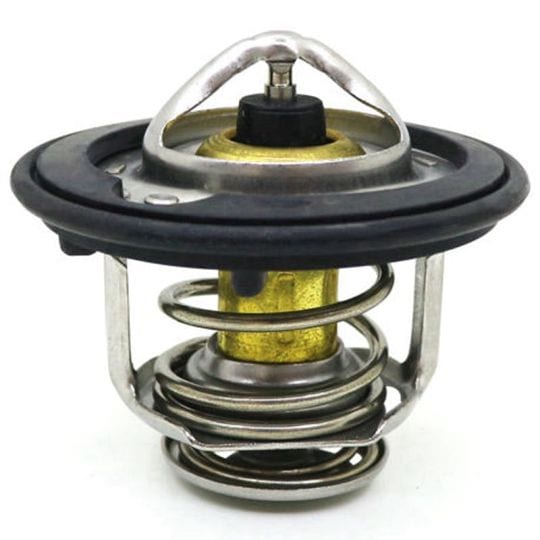
Что такое термостат и для чего он нужен?
Содержание
- Что это такое?
- Для чего нужен термостат?
- Где находится термостат в автомобиле?
- Устройство и принцип работы термостата
- Типы и виды термостатов
- Проверка термостата в автомобиле
- Горячий и холодный термостат. Температура открытия
- Какие бывают неисправности?
- Можно ли ездить без термостата
- Видео — проверка работы
- Вопросы и ответы:
Термостат – один из элементов системы охлаждения двигателя. Это устройство позволяет поддерживать рабочую температуру мотора, пока он заведен.
Рассмотрим, какую функцию выполняет термостат, его устройство, а также возможные неисправности.
Что это такое?
Если коротко, то термостат это клапан, который реагирует на изменение температуры среды, в которой он находится. В случае с системой охлаждения мотора данное устройство устанавливается на развилке двух рукавов магистрали. Один образует так называемый малый круг циркуляции, а другой – большой.
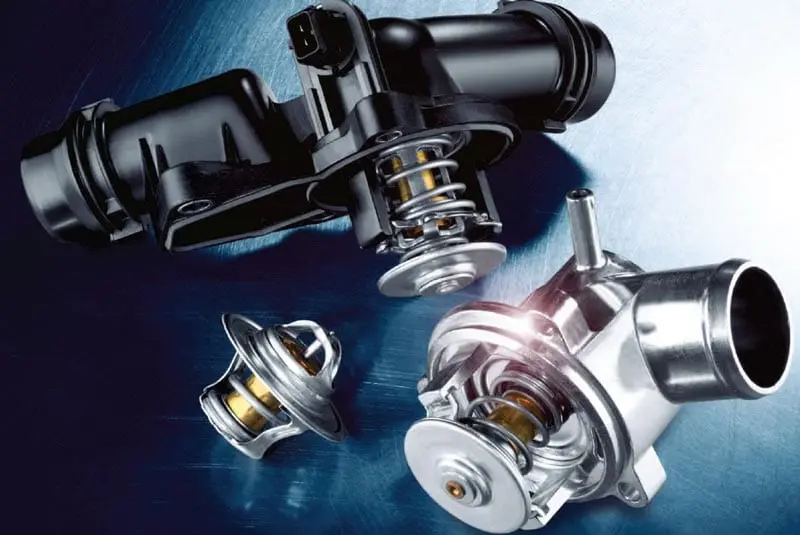
Для чего нужен термостат?
Всем известно, что в процессе работы двигатель сильно нагревается. Чтобы он не вышел из строя от чрезмерно высокой температуры, в нем имеется охлаждающая рубашка, которая подсоединена при помощи патрубков к радиатору.
В результате простоя автомобиля весь смазочный материал постепенно стекает в масляный поддон. Получается, в холодном моторе практически нет смазки. Учитывая этот фактор, когда заводится ДВС, ему нельзя давать большие нагрузки, чтобы его детали не износились быстрее обычного.
Холодное масло в поддоне более вязкое, чем при работе силового агрегата, поэтому насосу сложней его перекачать во все узлы. Для ускорения процесса двигатель должен как можно быстрее выйти на рабочую температуру. Тогда масло станет более текучим, и детали быстрее смажутся.
Перед первыми разработчиками автомобилей стояла непростая задача: что сделать, чтобы мотор быстро прогрелся, но при работе его температура была стабильной? Для этого система охлаждения была модернизирована, и в ней появилось два контура циркуляции. Один обеспечивает быстрый нагрев всех отделов мотора (антифриз или тосол нагревается от горячих стенок цилиндров и передает тепло на весь корпус ДВС). Второй используется для того, чтобы охлаждать агрегат, когда он вышел на рабочую температуру.
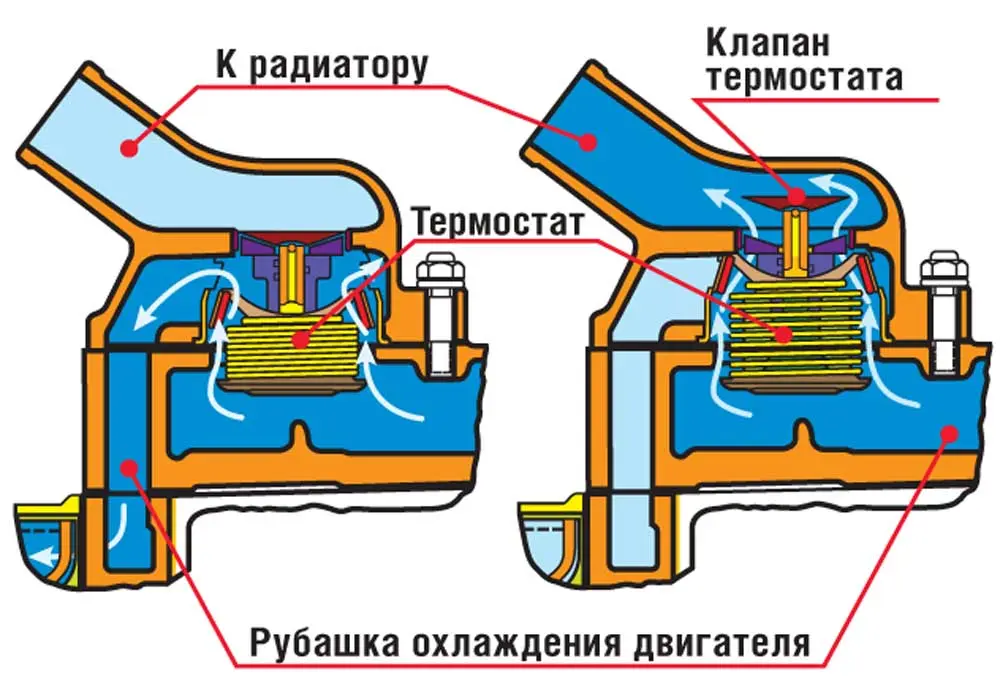
Термостат в данной системе играет роль клапана, который в нужный момент деактивирует обогрев мотора, и подключает радиатор для поддержания рабочей температуры ДВС. Благодаря чему достигается такой результат?
Где находится термостат в автомобиле?
В большинстве моделей авто термостат выглядит практически одинаково за исключением некоторых конструктивных особенностей. Термостат будет стоять на стыке патрубков, идущих от двигателя и от радиатора охлаждения. Эти элементы будут подсоединяться к корпусу термостата. Если этот механизм не имеет корпуса, то он будет установлен в рубашке двигателя (корпус блока цилиндров).
Независимо от места положения термостата, от него обязательно будет отходить минимум один патрубок системы охлаждения, идущий к радиатору.
Устройство и принцип работы термостата
В конструкцию термостата входит:
- Цилинднр. В основном его корпус изготавливается из меди. Этот металл имеет хорошую теплопроводность.
- Внутри него находится наполнитель. В зависимости от модели детали он может быть выполнен из воды и спирта, а может быть из воска, смешанного с порошком меди, алюминия и графита. Этот материал имеет большой коэффициент термического расширения. Пока воск холодный, он твердый. По мере нагрева он расширяется.
- Шток из металла. Он помещен внутри цилиндра.
- Резиновый уплотнитель. Этот элемент не дает наполнителю попасть в охлаждающую жидкость и перемещает шток.
- Клапан. Этих элементов в устройстве два – один в верхней части термостата, а другой в нижней (в некоторых моделях он один). Они открывают/закрывают малый и большой контур.
- Корпус. На нем фиксируются оба клапана и цилиндр.
- Пружины обеспечивают необходимое сопротивление движению штока.
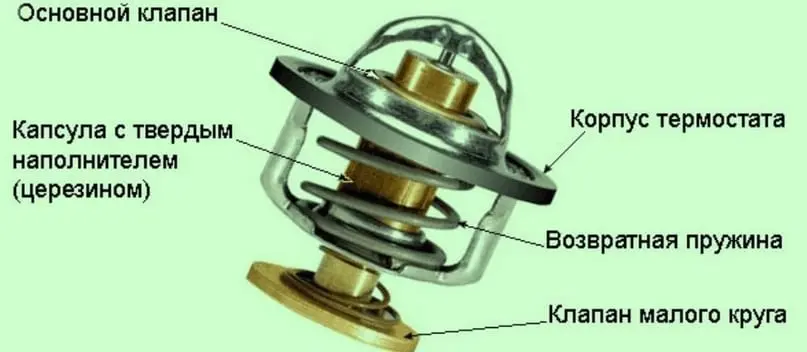
Вся конструкция помещается внутрь разветвления между малым и большим кругом. С одной стороны к узлу подсоединен входной патрубок малого контура, с другой – вход большого. Выход из разветвления один.
Пока охлаждающая жидкость циркулирует по малому кругу, она постепенно нагревает цилиндр термостата. Постепенно температура среды повышается. Когда показатель достигает от 75 до 95 градусов, воск уже растаял (металлические гранулы ускоряют процесс) и начинает расширяться. Так как ему не хватает места в полости, он давит на резиновое уплотнение штока.
Когда силовой агрегат прогрелся в достаточной мере, клапан большого круга начинает открываться, и антифриз (или тосол) начинает движение по большому кругу через радиатор. Так как работа штока напрямую зависит от температуры жидкости в канале, устройство позволяет поддерживать оптимальную температуру мотора в любое время года: летом не дает ему перегреться, а зимой – быстро выйти на рабочую температуру.
Независимо от модификаций термостатов все они работают по одному принципу. Единственное отличие между ними – диапазоном температур, при которых срабатывает клапан. Этот параметр зависит от марки двигателя (у каждой из них своя рабочая температура, поэтому и клапан должен открываться в заданном диапазоне).
В зависимости от региона, в котором эксплуатируется автомобиль, следует подбирать и термостат. Если основная часть года достаточно жаркая, тогда следует поставить термостат, который срабатывает при меньшей температуре. В более холодных широтах – наоборот, чтобы мотор в достаточной степени прогрелся.
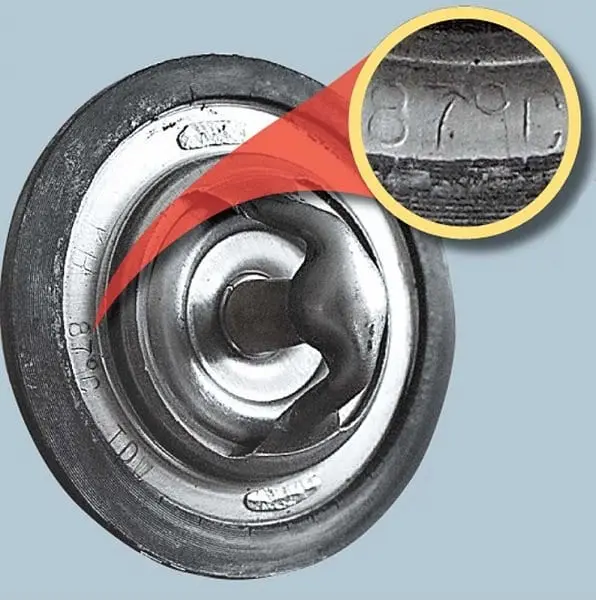
Чтобы автомобилист не установил неподходящую деталь, производитель указывает на корпусе устройства параметр открывания клапана.
Помимо этого все термостаты отличаются друг от друга:
- Числом клапанов. Самая простая конструкция – с одним клапаном. Такие модификации используются в старых авто. В большинстве современных автомобилях используется двухклапанный вариант. В таких модификациях клапаны закреплены на одном штоке, что обеспечивает их синхронное движение.
- Одна и две ступени. В классических охлаждающих системах используются одноступенчатые модели. Если в контуре жидкость проходит под давлением, тогда устанавливают двухступенчатые термостаты. В таких моделях клапан состоит из двух элементов. Один из них срабатывает при меньшем усилии, чтобы сбросить давление, а после этого активируется второй.
- С корпусом и без него. Большинство моделей бескорпусные. Для его замены нужно разобрать узел, в котором он устанавливается. Чтобы облегчить задачу, производители реализуют некоторые модификации уже собранные в специальном блоке. Достаточно подсоединить соответствующие патрубки.
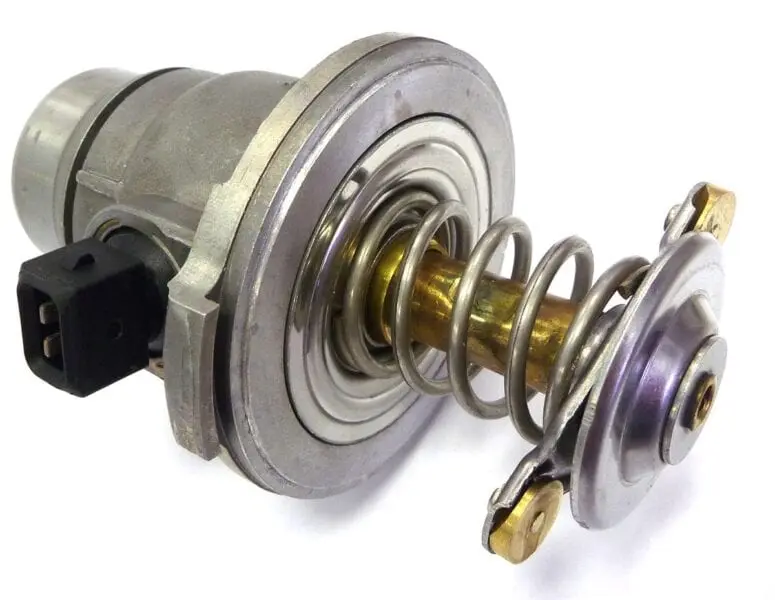
- С подогревом. На некоторых автомобилях устанавливаются термостаты с термодатчиком и системой подогрева цилиндра. Такие устройства управляются ЭБУ. Основная задача таких приспособлений – изменить температурный диапазон открытия клапана. Если мотор работает без сильных нагрузок, то термостат работает в штатном режиме. Если на агрегат оказывается дополнительная нагрузка, электронный подогрев заставляет клапан открыться раньше (температура охлаждающей жидкости приблизительно на 10 градусов ниже). Такая модификация позволяет немного сэкономить топливо.
- Размерами. В каждой системе охлаждения используются патрубки не только разной длины, но и диаметра. В связи с этим параметром должен подбираться и термостат, иначе антифриз будет беспрепятственно поступать из малого контура в большой и наоборот. Если покупается корпусная модификация, то в ней будет указан диаметр патрубков и их угол наклона.
- Комплектацией. Этот параметр зависит от поставщика. Одни продавцы реализуют устройства с уплотнительными прокладками высокого качества, а другие кладут в комплект менее качественный расходник, но предлагают купить более долговечный аналог.
Типы и виды термостатов
Среди всех разновидностей термостатов встречаются:
- Одноклапанные;
- Двухступенчатые;
- Двухклапанные;
- Электронные.
Ключевое отличие этих модификаций в принципе открывания и в числе клапанов. Самым простым типом термостата является одноклапанный. Таким механизмом оснащается много моделей зарубежного производства. Работа термостата сводится к тому, что клапан при достижении конкретной температуры открывает контур большого круга циркуляции без перекрытия малого контура.
Двухступенчатые термостаты используются в системах, охлаждающая жидкость в которых находится под большим давлением. Конструктивно это такая же одноклапанная модель. Ее тарелка состоит из двух элементов разного диаметра. Вначале срабатывает малая тарелка (из-за маленького диаметра она легче перемещается в контуре с большим давлением), а за ней круг перекрывается большой тарелкой. Так в данных системах включается круг охлаждения мотора.
Двухклапанная модификация термостатов применяется в устройстве систем охлаждения отечественных автомобилей. На одном приводе устанавливается два клапана. Один отвечает за контур большого круга, а другой – малого. В зависимости от положения привода перекрывается один из кругов циркуляции.

В электронных термостатах помимо основного элемента, нагревающегося от температуры охлаждающей жидкости, устанавливается и дополнительный нагреватель. Он подключается к блоку управления. Управление таким термостатом производится ЭБУ, который определяет режим работы мотора и подстраивает систему охлаждения под этот режим.
Проверка термостата в автомобиле
Существует два способа проверки работоспособности устройства:
- Демонтируя из системы;
- Не снимая с машины.
Первый способ редко когда используется. Некоторые к нему прибегают, чтобы полностью убедиться в его работоспособности. Также этот метод позволит проверить работоспособность новой детали, так как в магазине это не получится сделать. Для этого нужно нагреть воду (кипяток — выше 90 градусов). Деталь опускают в емкость с кипятком.
Если спустя пару минут клапан не откроется, значит деталь неисправна — либо что-то случилось со штоком, либо с пружиной, а может и что-то произошло с емкостью, в которой находится воск. в этом случае термостат нужно заменить на новый.
Подробней о том, как проверить новую деталь, смотрите в видео:
Как определить, работает или нет?
Чтобы проверить работоспособность термостата, не снимая с машины, не нужно быть ведущим специалистом в области механики. Достаточно понимать принцип работы устройства. В первые минуты работы мотора вся система охлаждения не должна нагреваться. Учитывая это, необходимо сделать следующее:
- Завести двигатель и дать ему поработать.
- В этот момент следует попробовать патрубки, подсоединенные к радиатору. Если термостат исправный, система не будет нагреваться на протяжении до пяти минут (в зависимости от температуры окружающей среды). Холодная система говорит о том, что клапан закрыт.
- Далее смотрим на стрелку приборной панели. Если она быстро поднимается и уходит далеко за отметку в 90 градусов – пробуем патрубки снова. Холодная система свидетельствует о том, что клапан не срабатывает.

- В идеале должно происходить следующее: пока мотор прогревается, система охлаждения холодная. Как только он достиг нужной температуры, открывается клапан и антифриз идет по большому контуру. При этом байпас постепенно охлаждается.
Если существуют нарушения в порядке срабатывания термостата, лучше сразу его заменить.
Горячий и холодный термостат. Температура открытия
При замене термостата рекомендуется покупать заводской аналог. Он открывается при температуре ОЖ от 82 до 88 градусов. Но в некоторых случаях пригодится нестандартный термостат.
Например, существуют «холодные» и «горячие» термостаты. Первый тип устройств открываются при температуре около 76-78 градусов. Второй срабатывает, когда охлаждающая жидкость прогревается почти до 95 градусов.
Холодный термостат можно установить вместо штатного в автомобиль, мотор которого очень быстро прогревается и часто выходит на температуру кипения. Конечно, такая модификация системы охлаждения не устранит подобную проблему мотора, но плохо прогретый двигатель закипит немного позже.
если автомобиль эксплуатируется в северных широтах, то автомобилисты модифицируют систему охлаждения в сторону большей температуры открытия термостата. С установкой «горячего» варианта система охлаждения мотора не будет переохлаждать ДВС, что положительно скажется на работе печки.
Какие бывают неисправности?
Так как термостат всегда должен реагировать на изменения температуры в системе охлаждения мотора, он должен быть работоспособным. Рассмотрим основные неисправности термостата в системе охлаждения. По сути, их две: заблокировался в закрытом или открытом положении.
Заклинил в полностью закрытом положении
Если термостат перестал открываться, то во время работы мотора охлаждающая жидкость будет циркулировать только по малому кругу. Это значит, что двигатель будет должным образом нагреваться.
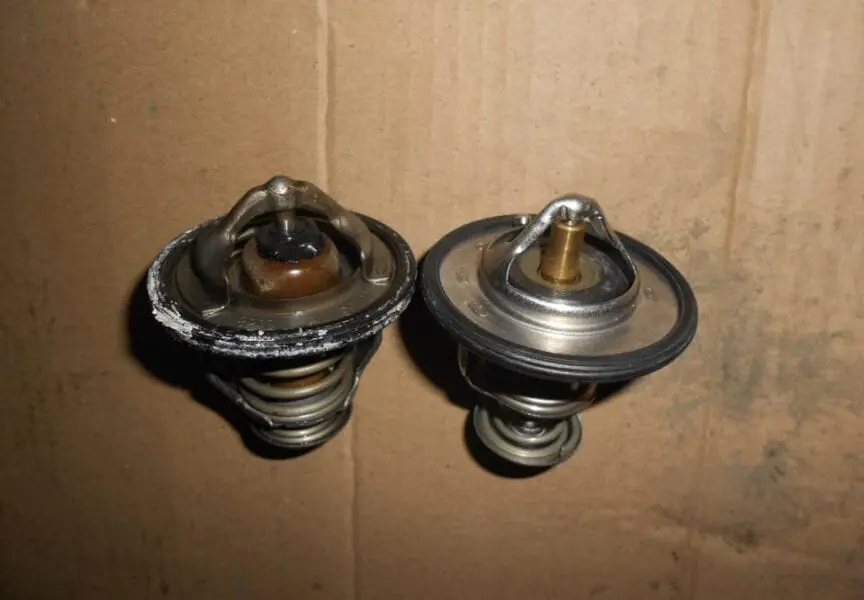
Но из-за того, что вышедший на рабочую температуру ДВС не получает необходимого охлаждения (антифриз не циркулирует по большому кругу, а значит, он не охлаждается в радиаторе), он очень быстро выйдет на критический показатель температуры. Причем ДВС может закипеть, даже когда на улице мороз. Чтобы устранить подобную неисправность, необходимо заменить термостат на новый.
«Завис» в полностью или частично открытом состоянии
В таком случае охлаждающая жидкость в системе со старта мотора сразу начинает циркулировать по большому кругу. Чтобы ДВС вышел на рабочую температуру (благодаря этому моторное масло должным образом прогреется, и качественно будет смазывать все детали агрегата), потребуется намного больше времени.
Если термостат вышел из строя зимой, то на морозе двигатель еще хуже будет прогреваться. Если летом в этом нет особой проблемы, то зимой в такой машине невозможно будет нагреться (радиатор печки будет холодным).
Можно ли ездить без термостата
Подобная мысль посещает автовладельцев, которые в летний период постоянно сталкиваются с перегревом машины. Они просто убирают термостат из системы, и антифриз при запуске ДВС сразу идет по большому кругу. Хотя сразу это не выводит мотор из строя, так делать не рекомендуется (инженеры не зря придумали и установили этот элемент в машину).
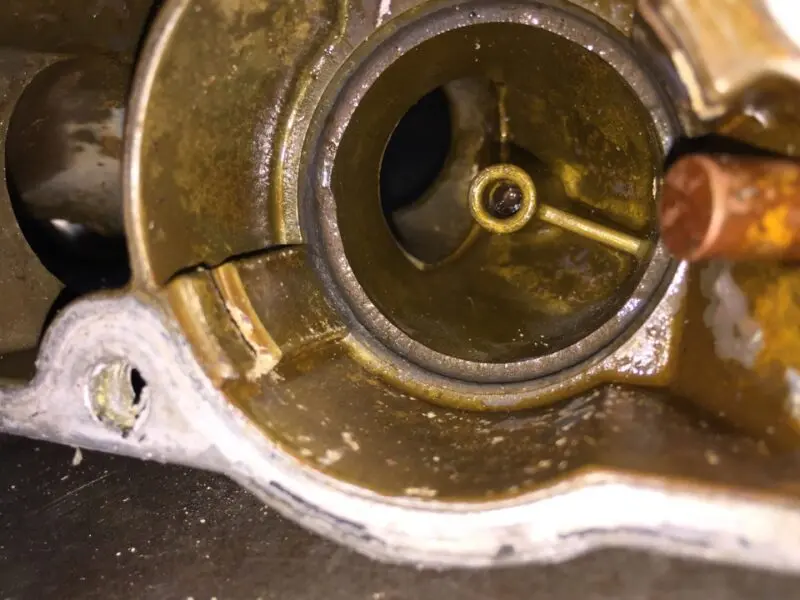
Причина в том, что термостат в машине нужен для стабилизации температурного режима мотора. Он не просто обеспечивает прогрев или охлаждение силового агрегата. Если убрать этот элемент из системы охлаждения, то автовладелец принудительно отключает контур прогрева ДВС. Но открытый термостат не только включает большой круг циркуляции.
Одновременно он перекрывает малый круг циркуляции. Если убрать термостат, то в зависимости от типа системы охлаждения помпа будет давить антифриз сразу по малому кругу даже если из системы удален термостат. Причина в том, что циркуляция будет всегда идти путем наименьшего сопротивления. Поэтому, желая устранить перегрев мотора, автомобилист может устроить локальные перегревы в системе.
Но плохо прогретый двигатель может пострадать не меньше, чем при перегреве. В холодном моторе (а при циркуляции сразу по большому кругу его температура может даже не достигать отметки в 70 градусов) плохо сгорает воздушно-топливная смесь, из-за чего в нем появится нагар, быстрее выйдут из строя свечи зажигания или накала, пострадает лямбда-зонд и катализатор.
Гораздо лучше при частых перегревах мотора не удалять термостат, а установить холодный аналог (открывается раньше). Также следует выяснить, почему двигатель так часто перегревается. Причина может быть в забитом радиаторе или плохо работающем вентиляторе.
Видео — проверка работы
Поломка термостата критична для двигателя. В дополнение ко всему познакомьтесь с подробным обзором принципа работы термостата, а также варианта проверки:
Вопросы и ответы:
Что такое термостат и для чего он нужен? Это устройство, которое реагирует на изменение температуры охлаждающей жидкости, и изменяет режим циркуляции тосола/антифриза в системе охлаждения.
Для чего служит термостат? Когда мотор холодный, ему нужно быстро нагреться. Термостат блокирует циркуляцию ОЖ по большому кругу, чтобы поддерживалась рабочая температура ДВС (зимой предотвращает замерзание мотора).
Какой ресурс у термостата? Срок службы термостата составляет около двух-трех лет. Это зависит от качества самой детали. Если его не заменить, мотор будет перегреваться или наоборот очень долго выходить на рабочую температуру.

